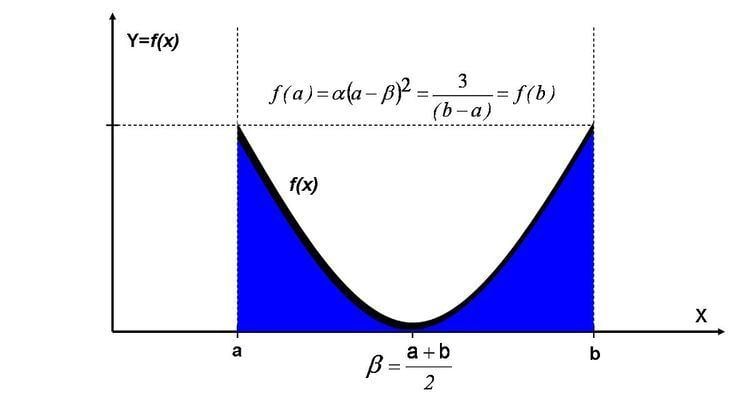 | ||
Parameters a : a ∈ ( − ∞ , ∞ ) {\displaystyle a:~a\in (-\infty ,\infty )} b : b ∈ ( a , ∞ ) {\displaystyle b:~b\in (a,\infty )} or α : α ∈ ( 0 , ∞ ) {\displaystyle \alpha :~\alpha \in (0,\infty )} β : β ∈ ( − ∞ , ∞ ) , {\displaystyle \beta :~\beta \in (-\infty ,\infty ),} Support x ∈ [ a , b ] {\displaystyle x\in [a,b]\!} PDF α ( x − β ) 2 {\displaystyle \alpha \left(x-\beta \right)^{2}} CDF α 3 ( ( x − β ) 3 + ( β − a ) 3 ) {\displaystyle {\alpha \over 3}\left((x-\beta )^{3}+(\beta -a)^{3}\right)} Mean a + b 2 {\displaystyle {a+b \over 2}} Median a + b 2 {\displaystyle {a+b \over 2}} | ||
In probability theory and statistics, the U-quadratic distribution is a continuous probability distribution defined by a unique quadratic function with lower limit a and upper limit b.
Contents
- Parameter relations
- Differential equation
- Related distributions
- Applications
- Moment generating function
- Characteristic function
- References
Parameter relations
This distribution has effectively only two parameters a, b, as the other two are explicit functions of the support defined by the former two parameters:
(gravitational balance center, offset), and
(vertical scale).
Differential equation
The pdf of this distribution is a solution of the following differential equation if parameters a and b are used:
If α and β are used as parameters, the equation becomes:
Related distributions
One can introduce a vertically inverted (
Applications
This distribution is a useful model for symmetric bimodal processes. Other continuous distributions allow more flexibility, in terms of relaxing the symmetry and the quadratic shape of the density function, which are enforced in the U-quadratic distribution – e.g., beta distribution and gamma distribution.
Moment generating function
Characteristic function
